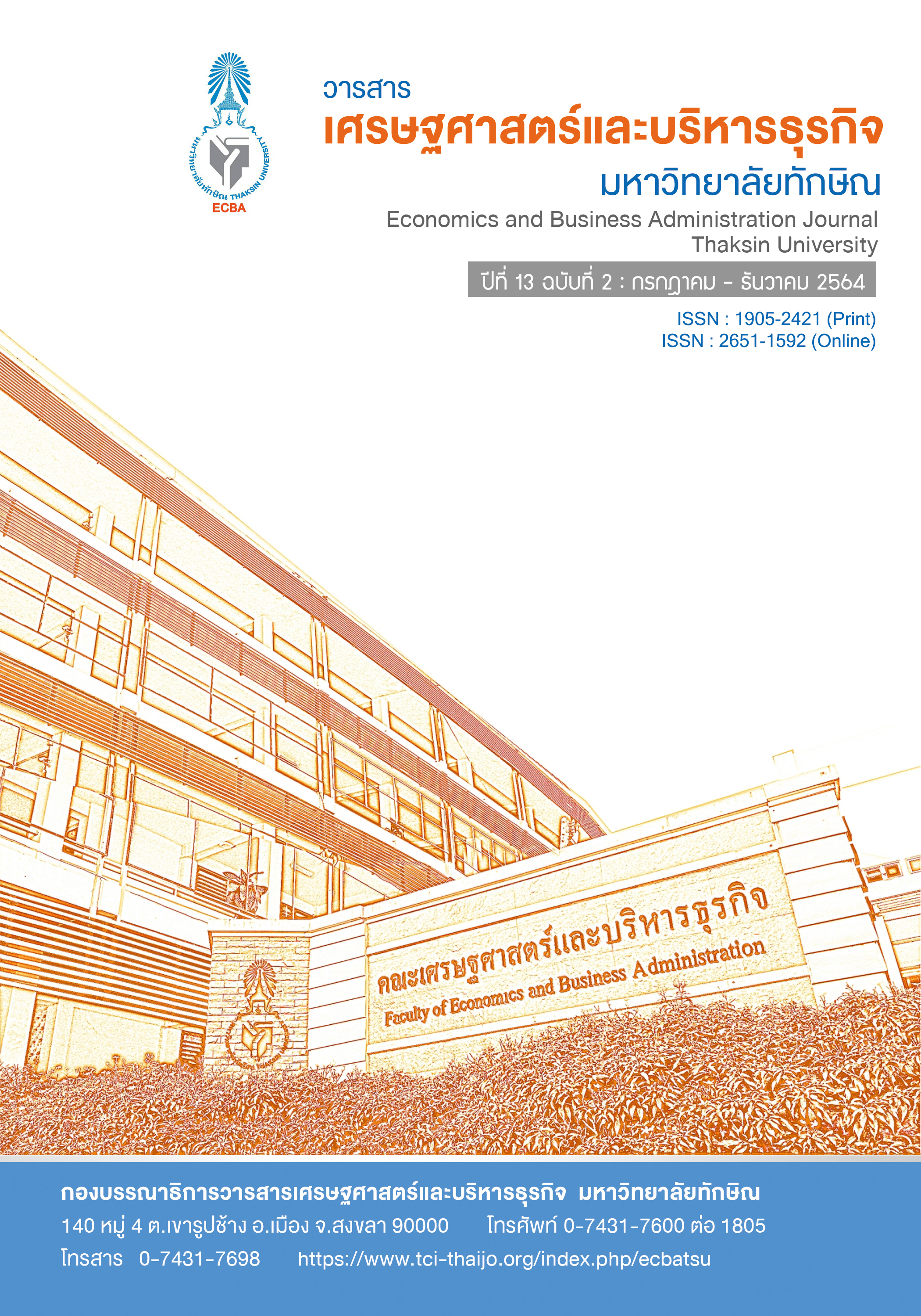The Influence of Tourist Attraction’s Image on Tourist’s Satisfaction and Loyalty in Songkhla Old Town
Keywords:
Tourist Attraction’s Image, Satisfaction, Loyalty, TouristsAbstract
The research aimed to investigate the effect of tourism image namely travel environment, accessibility, price and value, infrastructure and heritage attractions on satisfaction, and study tourist satisfaction influence to tourist loyalty. The sample included 300 tourist’s visitors to the old town of Songkhla province, using the purposive sampling method. The questionnaire was utilized as well as data analysis comprising 1) basic statistics using SPSS program, and 2) the relationship between variables using the Partial Least Squares Structural Equation Modelling (PLS-SEM). The results showed that travel environment, accessibility, infrastructure, and heritage attractions affect tourist satisfaction and tourist satisfaction has a positive effect on tourist loyalty toward continuing tourist’s visitors to the old town of Songkhla province. However, this study found that price and value factors did not influence the satisfaction of tourist visitors to the old town of Songkhla province.
References
Amshaw, S. (2018). Guidelines for support revisiting in community-based tourism in Chiang Mai. Research and Development Journal, Loei Rajabhat University. 13 (44), 90-99.
Bunnag, R. (2013). Cultural heritage. Retrieved from http://www.marutbunnag.com/article/ 407/.
Chin, W. W., Marcolin, B. L. & Newsted, P. R. (2003). A partial least squares latent variable modeling approach for measuring interaction effects: Results from a Monte Carlo Simulation Study and an Electronic-mail Emotion/Adoption Study. Information Systems Research, 14(2), 189-217.
Cohen John M & Uphoff Norman. (1977). Rural development participation: Concepts and measures for project design, Implementation and evaluation. Cornell University, No.2, pp.317.
Chouwasukum, W. & Suvannin, W. (2018). The strategies for sustainable tourism development of cultural floating market: A Case Study Floating Market Samchuk, Suphanburi Province. Journal of MCU Social Science Review, 7(4), 123-135.
Department of tourism. (2018). The tourism development strategic plan 2018-2021. Retrieved from https://www.dot.go.th/.
Hair, J. F., Hult, G. T. M., Ringle, C. & Sarstedt, M. (2013). A primer on partial least squares structural equation modeling (PLS-SEM): Sage Publications.
Hashemi, S., Kiumarsi, S. & Marzuki A. (2019). Tourist Satisfaction and destination Loyalty in Heritage Sites of Shiraz, Iran. Experiencing Persian Heritage: Perspectives and Challenges Bridging Tourism Theory and Practice, (10), 223-255. doi:10.1108/S2042-144320190000010015.
Janchai, N., Apirat, S., Marksap, P. & Yenchaiyapruek, R. (2018). A structural model of influential factors on tourist loyalty: an empirical study of floating markets. Journal of MCU Peace Studies, 6(3), 1080-1094.
Jankingthong, W. (2014). Destination image in Thailand. Silpakorn University Journal, 34(1), 31-50.
Jankingthong, W. (2015). Structural equation model of factors affecting thai tourist loyalty toward national parks land in southern Thailand. Silpakorn University Journal, 35(2), 1-18.
Jankingthong, W. (2014). Theory of planned behavior and tourist loyalty. Silpakorn University Journal, 34(2), 131-146.
Jansri W. (2019). Perception of residents, community participation and support for tourism development in the old town Muang Songkhla, Thailand. Proceeding of 13th International RAIS Conference on Social Sciences and Humanities, 64-71. doi: 10.5281/zenodo.3267502.
Likert R. (1967). The Method of Constructing and Attitude Scale. In Reading in Fishbeic, M (Ed.), Attitude Theory and Measurement, 90-95. New York: Wiley & Son.
Luekveerawattana, R. & Ritthichairoek, A. (2017). Studying personal factors’ satisfactions toward the marketing mix of Don Hoi Lot in SamutSongkhram. Silpakorn University Journal, 38(2), 103-120.
Office of the National Economic and Social Development Council. (2019). Southern development plan during the 12th national economic and social development plan (2017-2022) Revised Edition. Retrieved from http://www.nesdc.go.th/.
Phromburom, T. & Kimphakorn, N. (2015). Factors affecting tourist experience of eco, culture, and wellness tourism in the upper northern provincial cluster 1 of thailand: Chiang mai, Lamphun, Lampang, Mae hong son. Journal of Thai Hospitality and Tourism, 10(1), 71-87.
Poltanee, I. & Boonphetkaew, U. (2018). A study on potential of tourist attractions on Tao Island in Surat Thani Province as a guideline to promote sustainable tourism. Silpakorn University Journal, 38(5), 18-39.
Rattanaprakarn, R., Suwanchat, J. & Srisuk, S. (2017). Heritage trust with the development of Songkhla old town. Retrieved from www.slideshare.net/ FURD_RSU/heritage-trust.
Robinson, S. & Etherington, L. (2006). Customer loyalty: a guide for time travelers. New York: Palgrave Macmillan.
Saeho, K. (2016). Tourism image, service quality image, and tourism values affecting sustainable tourism attitudes: case study of natural based tourism of thai working–age tourists in bangkok. Bangkok University.
Saenglaor, C. & Kornpetpanee, S. (2015). A causal relationship model of destination loyalty in the eastern region of the Thai tourists. Research Methodology & Cognitive Science, 12(2), 23-34.
Sangkapan, J., Boonprakarn, K., Wangbenmat, C., Remegio, K. & Atimatmaitree, A. (2016). Tourist satisfaction towards klong hae floating market, Hat Yai District, Songkhla Province. Journal of Management Sciences, 33(1), 25-50.
Saymany, T. & Nilplub, C. (2019). The effect of tourism image and satisfaction on tourist loyalty in Vientiane Capital, Lao people’s democratic republic. RMUTI Journal Humanities and Social Sciences, 6(1), 126-141.
Sittisapphaisan, C. (2016). The influence of tourists’ satisfaction, word of mouth, and perceived value on their revisit for tour Bike at Khung Bang Kachao. Bangkok University.
Stevens, J. (2002). Applied multivariate statistics for the social sciences (4th ed.). Mahwah, NJ: Lawrence Erlbaum Associates.
Suansri, M. (2016). Tourists’s satisfaction towards tourist attractions for learning in Pathum Thani Province. Journal of Thai Hospitality and Tourism, 11(1), 69-79.
Sujasen, A., Thadthiam, N., Chewiratnachote, K. & Chomchit, K. (2018). Study the image of Nakhon Si Thammarat tourist attraction according to the opinions of foreign tourists. Pathumthani University Academic Journal, 10(2), 234-246.
Sukvong, S. (2015). Attitudes and satisfaction of the chinese tourists towards their decisions to visit Bangkok. Bangkok University.
Tangtenglam, S. (2019). Factors affecting to chatuchak weekend market of foreigner tourists. Journal of Arts Management, 3(3), 141-152.
TAT Intelligence Center. (2020). Tourist statistics. Retrieved from https://intelligencecenter.tat.or.th/.
Tungsawat, S. (2019). The influence of tourist behavior and tourism management on tourist’s satisfaction of khmer civilization route. Journal of MCU Social Science Review. 8(2), 180-191.
Wongkangwan, A., Phangnirun, B., Srisansuk, W., Tridhosakun, P., Thanasrisuebwong, A. & Techarattanaset, N. (2013). Antecedent and loyalty of foreign tourists for tourist attractions in Bangkok Metropolitan Area. Research and Development Journal Suan Sunandha Rajabhat University, (38), 85-99.




